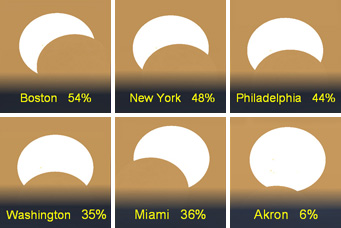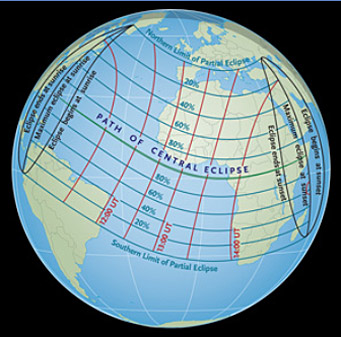October 29, 2013
Contact:
Tony Flanders, Associate Editor, Sky & Telescope
855-638-5388 x2173, [email protected]
Alan MacRobert, Senior Editor, Sky & Telescope
855-638-5388 x2151, [email protected]
On Sunday morning November 3, 2013, early risers in much of eastern North America can witness the Sun rising while it's in the midst of a partial eclipse. “It'll be a weird and dramatic spectacle, if your eastern horizon is clear,” says Robert Naeye, Editor in Chief of Sky & Telescope magazine. "Here's a chance to take some amazing photos."

Weather permitting, early risers along the Eastern Seaboard can see a partial solar eclipse at sunrise on November 3, 2013. The percents tell how much of the Sun's surface the Moon will cover.
Sky & Telescope illustration / source: Stellarium
The eclipse will be total only along a narrow path over the Atlantic Ocean and equatorial Africa. But a much larger part of the world will see the partial phase of the eclipse, including most of Africa, the Middle East, southernmost Europe, northern South America, and the Caribbean.
From the eastern U.S. and Canada, the viewing will be tricky but potentially spectacular. You’ll need an open view of the eastern horizon, and the farther east you are the better. Seen from near the East Coast, the Sun will rise with a big bite out of its lower portion, as shown at right. This is the silhouette of the new Moon just as it begins its next monthly course around the sky.
The bite will then diminish and disappear (in less than 45 minutes most places) as the Moon moves along its orbit, while the Sun climbs higher into your morning sky.
“I’ll be out bright and early,” says Alan MacRobert, a senior editor of Sky & Telescope in Cambridge, Massachusetts. “I’ve got a hillside scouted out with a good view of the east horizon where the Sun will come up.”
In places farther inland, the Sun will rise with only a small nick that lasts for only a short time. The western limit of visibility runs through southern Ontario, Ohio, Kentucky, Tennessee, Alabama, and the Florida Panhandle — and that’s only if you have a completely flat eastern horizon.
Occasionally, the rising or setting Sun is reddened and dimmed enough to be viewed directly — but usually it’s not. Bring a safe solar filter to protect your eyes from possible permanent injury, including by invisible infrared light. This is especially important if you’re using optical aid. Always use a proper solar filter when looking at the bright Sun, whether during a partial eclipse or at any other time. Sky & Telescope offers tips for observing the Sun safely.
If you want to take good pictures, use a telephoto lens (100- to 500-mm focal length) to enlarge the Sun to a reasonable size while including some nice foreground.
Cartographer Michael Zeiler presents detailed maps and graphical information on his website. In particular, see his diagram of how the rising Sun will appear as seen from many more cities.
Here is Fred Espenak's timetable of the eclipse for many locations Times are in Universal Time (GMT).
TIME WARNING: Daylight saving time ends just hours earlier (for most of North America), at 2 a.m. Sunday morning in each time zone. So make sure you are using standard time, not daylight, both for finding your local time of sunrise on November 3rd and for setting your alarm clock!
Where the Eclipse Is Total (and Annular)

The solar eclipse on November 3, 2013, begins annular (at the far-left end of the central green line) but quickly becomes total as the Moon's umbra crosses the Atlantic Ocean, then central Africa. The eclipse is partial over a much wider region, as mapped by the grid. For your location, interpolate between the red lines to estimate the Universal Time of maximum eclipse, and between the blue lines for the fraction of the Sun's diameter that will be covered then. Click image for high-res version.
Sky & Telescope illustration / Fred Espenak
This eclipse is unusual for astronomers: it's called a “hybrid” solar eclipse. Where the Moon passes directly across the Sun’s center — along that line crossing the Atlantic and Equatorial Africa — the eclipse starts off as annular, with a thin ring of the Sun showing all around the Moon, over a small bit of the Atlantic. It then becomes a relatively brief total eclipse for the rest of the way.
The path of the total eclipse is only 29 miles wide (47 km) when it makes landfall in Gabon, where totality will last 68 seconds. Then the Moon’s shadow speeds east-northeastward across Congo (up to 53 seconds), Democratic Republic of the Congo (44 seconds), Uganda (19 seconds), and northern Kenya (13 seconds), before ending in southern Ethiopia and westernmost Somalia (1 second, at sunset).
During the previous hybrid solar eclipse in April 2005, a stretch of totality was sandwiched between annular views at the beginning and end. This year's is especially rare because it begins with annularity and ends with totality.
Sky & Telescope magazine’s contributing editor J. Kelly Beatty is leading an eclipse expedition to Kenya, where, he says, “we’re hoping to see 11 seconds of totality. That’s not very long — no time to be fumbling with camera settings! — but we'll be rewarded with astounding views of Baily's beads and long crimson arcs of the Sun's chromosphere.” That’s if the weather permits. “Wish us luck!”
Getting Ready for the Big One
Another partial eclipse of the Sun will occur on October 23, 2014, this time for most of North America except New England.
But the really big event that eclipse-watchers have been awaiting happens on August 21, 2017. On that day a total eclipse of the Sun will sweep across the United States from Oregon to South Carolina, with partial phases visible all across the continent.
For more skywatching information and astronomy news, visit SkyandTelescope.com or pick up Sky & Telescope, the essential magazine of astronomy since 1941.
Sky Publishing (a New Track Media company) was founded in 1941 by Charles A. Federer Jr. and Helen Spence Federer, the original editors of Sky & Telescope magazine. In addition to Sky & Telescope and SkyandTelescope.com, the company publishes two annuals (Beautiful Universe and SkyWatch), as well as books, star atlases, posters, prints, globes, and other fine astronomy products.
 0
0
Comments
You must be logged in to post a comment.